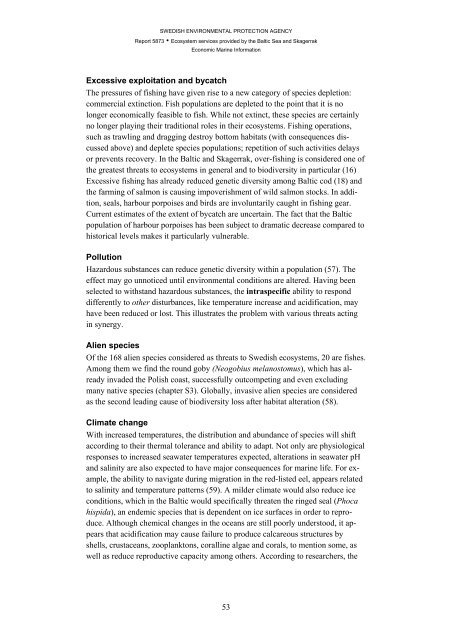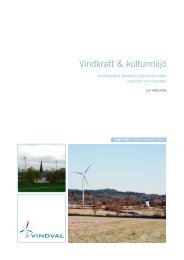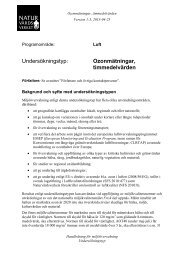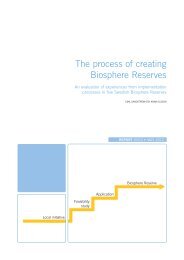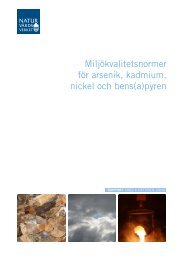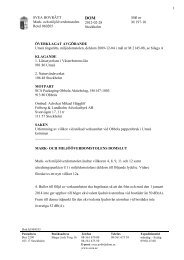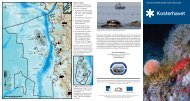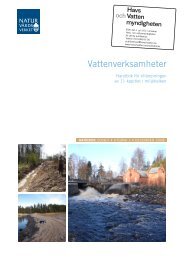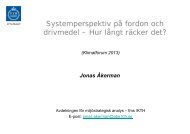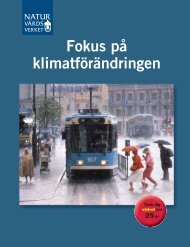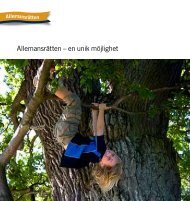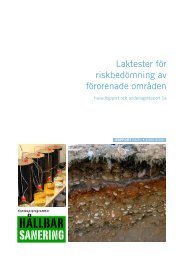Ecosystem services provided by the Baltic Sea ... - Naturvårdsverket
Ecosystem services provided by the Baltic Sea ... - Naturvårdsverket
Ecosystem services provided by the Baltic Sea ... - Naturvårdsverket
You also want an ePaper? Increase the reach of your titles
YUMPU automatically turns print PDFs into web optimized ePapers that Google loves.
SWEDISH ENVIRONMENTAL PROTECTION AGENCY<br />
Report 5873 • <strong>Ecosystem</strong> <strong>services</strong> <strong>provided</strong> <strong>by</strong> <strong>the</strong> <strong>Baltic</strong> <strong>Sea</strong> and Skagerrak<br />
Economic Marine Information<br />
Excessive exploitation and <strong>by</strong>catch<br />
The pressures of fishing have given rise to a new category of species depletion:<br />
commercial extinction. Fish populations are depleted to <strong>the</strong> point that it is no<br />
longer economically feasible to fish. While not extinct, <strong>the</strong>se species are certainly<br />
no longer playing <strong>the</strong>ir traditional roles in <strong>the</strong>ir ecosystems. Fishing operations,<br />
such as trawling and dragging destroy bottom habitats (with consequences discussed<br />
above) and deplete species populations; repetition of such activities delays<br />
or prevents recovery. In <strong>the</strong> <strong>Baltic</strong> and Skagerrak, over-fishing is considered one of<br />
<strong>the</strong> greatest threats to ecosystems in general and to biodiversity in particular (16)<br />
Excessive fishing has already reduced genetic diversity among <strong>Baltic</strong> cod (18) and<br />
<strong>the</strong> farming of salmon is causing impoverishment of wild salmon stocks. In addition,<br />
seals, harbour porpoises and birds are involuntarily caught in fishing gear.<br />
Current estimates of <strong>the</strong> extent of <strong>by</strong>catch are uncertain. The fact that <strong>the</strong> <strong>Baltic</strong><br />
population of harbour porpoises has been subject to dramatic decrease compared to<br />
historical levels makes it particularly vulnerable.<br />
Pollution<br />
Hazardous substances can reduce genetic diversity within a population (57). The<br />
effect may go unnoticed until environmental conditions are altered. Having been<br />
selected to withstand hazardous substances, <strong>the</strong> intraspecific ability to respond<br />
differently to o<strong>the</strong>r disturbances, like temperature increase and acidification, may<br />
have been reduced or lost. This illustrates <strong>the</strong> problem with various threats acting<br />
in synergy.<br />
Alien species<br />
Of <strong>the</strong> 168 alien species considered as threats to Swedish ecosystems, 20 are fishes.<br />
Among <strong>the</strong>m we find <strong>the</strong> round go<strong>by</strong> (Neogobius melanostomus), which has already<br />
invaded <strong>the</strong> Polish coast, successfully outcompeting and even excluding<br />
many native species (chapter S3). Globally, invasive alien species are considered<br />
as <strong>the</strong> second leading cause of biodiversity loss after habitat alteration (58).<br />
Climate change<br />
With increased temperatures, <strong>the</strong> distribution and abundance of species will shift<br />
according to <strong>the</strong>ir <strong>the</strong>rmal tolerance and ability to adapt. Not only are physiological<br />
responses to increased seawater temperatures expected, alterations in seawater pH<br />
and salinity are also expected to have major consequences for marine life. For example,<br />
<strong>the</strong> ability to navigate during migration in <strong>the</strong> red-listed eel, appears related<br />
to salinity and temperature patterns (59). A milder climate would also reduce ice<br />
conditions, which in <strong>the</strong> <strong>Baltic</strong> would specifically threaten <strong>the</strong> ringed seal (Phoca<br />
hispida), an endemic species that is dependent on ice surfaces in order to reproduce.<br />
Although chemical changes in <strong>the</strong> oceans are still poorly understood, it appears<br />
that acidification may cause failure to produce calcareous structures <strong>by</strong><br />
shells, crustaceans, zooplanktons, coralline algae and corals, to mention some, as<br />
well as reduce reproductive capacity among o<strong>the</strong>rs. According to researchers, <strong>the</strong><br />
53


